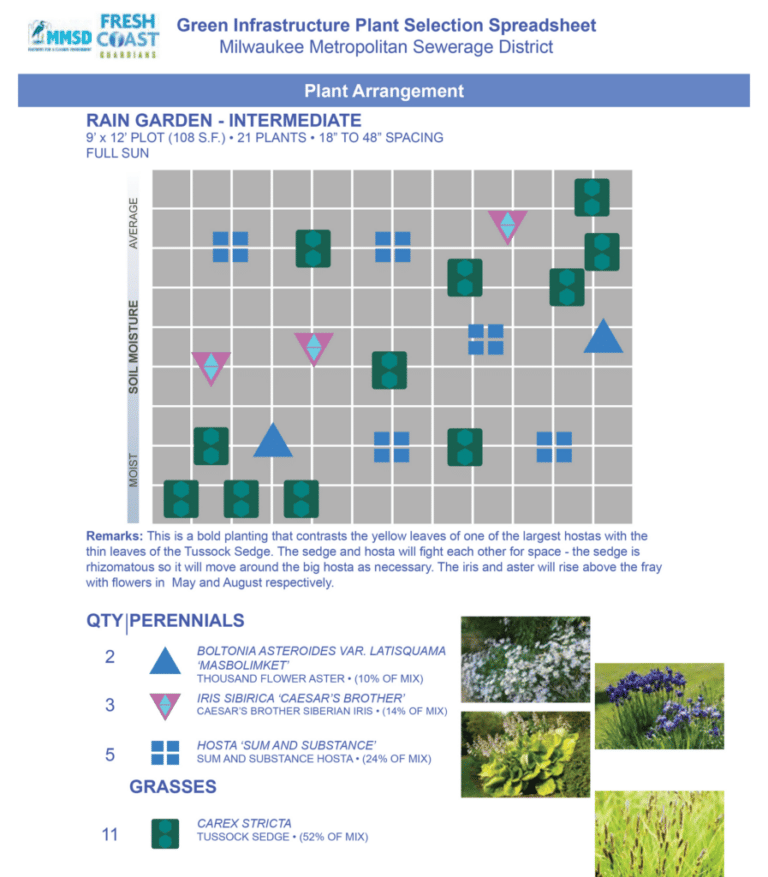Wisconsin American Society of Landscape Architects Merit Award

Jason Cooper (WR, Lombard) accepted the Wisconsin American Society of Landscape Architects (ASLA) Merit Award on behalf of ECT’s Lombard team for the Green Infrastructure Plant Selection Tool that he created for the Milwaukee Metropolitan Sewerage District (MMSD). The GI plant selection tool was designed to help project partners and interested residents with the selection of plants for green infrastructure applications. The Wisconsin ALSA presented the 2021 Professional Project Awards via zoom call on Thursday, July 15, 2021. The Green Infrastructure Plant Selection tool won in the categories of “analysis and planning” and for projects larger than 10 acres.
The concept of green infrastructure promises many wonderful benefits. Cleaner water, increased infiltration, and added habitat for native plants and animals. Maintaining an environment where plants can thrive, however, is challenging. Picking the right plants for green infrastructure requires a thorough understanding of the site’s ecology and long-term stewardship.
To make this step easier, ECT Landscape Architect Jason Cooper researched plant attributes and partnered with MMSD to create a plant selection tool for green infrastructure tailored for their region. Users can download the interactive excel tool directly from the MMSD’s website. Jason and project partners applied their knowledge of the variety of conditions that plants are exposed to in green infrastructure practices to develop the plant lists offered in the tool. A master list was created for both ornamental and naturalized planting approaches.


How does Plant Selection Tool work?
Step 1: Users are asked to choose an ornamental or naturalized panting approach. Users are giving pros and cons for each planting approach as well as cost considerations.
Step 2: Allows users to input unique conditions for their planting site. If a user is unfamiliar with the conditions, they can choose one of the default selections for each green infrastructure practice.
Step 3: After all the options are selected, the tool generates a custom plant list containing trees, shrubs, and herbaceous grasses and perennials that are appropriate for that site’s unique ecology. Again, if users are not familiar with the site’s specific conditions, they can select default settings for each green infrastructure practice.
The master plant list identifies which plants are native to the Midwest and southern Wisconsin. The naturalized plant list contains more than 80 plants known to be native to southeast Wisconsin. The ornamental list is much larger and contains more than 500 plants.
The custom plant list comes with the following supportive information:
- A template for landscape maintenance.
- Flowering information for each plant’s flowering season, color, and height.
- Plant patterns (beginner, intermediate, advanced) for the default condition of each green infrastructure application.
- Each pattern recommends a grass and forb matrix that provides dense groundcover throughout all four seasons.
Jason and the MMSD intend for the customized plant lists generated by the tool to be a good starting point in the design process. There is a disclaimer on the opening page of the tool that it is “recommended that planting plans be developed and/or reviewed by a licensed landscape architect, landscape designer, or qualified tradesperson.”


More about our project partner, MMSD
MMSD is a strong supporter of green infrastructure. They have partnered with public and private property owners to install a wide variety of it throughout the 28 municipalities in their service area. They see green infrastructure as an important strategy for meeting their 2035 Vision for a healthier Milwaukee region. The goals outlined in this vision include zero basement backups, zero overflows, and the capture of the first half inch of rainfall on impervious surfaces in their service area. This is the equivalent to approximately 740 million gallons of stormwater.
Contact Jason Cooper for more information about the Green Infrastructure Plant Selection Tool.




